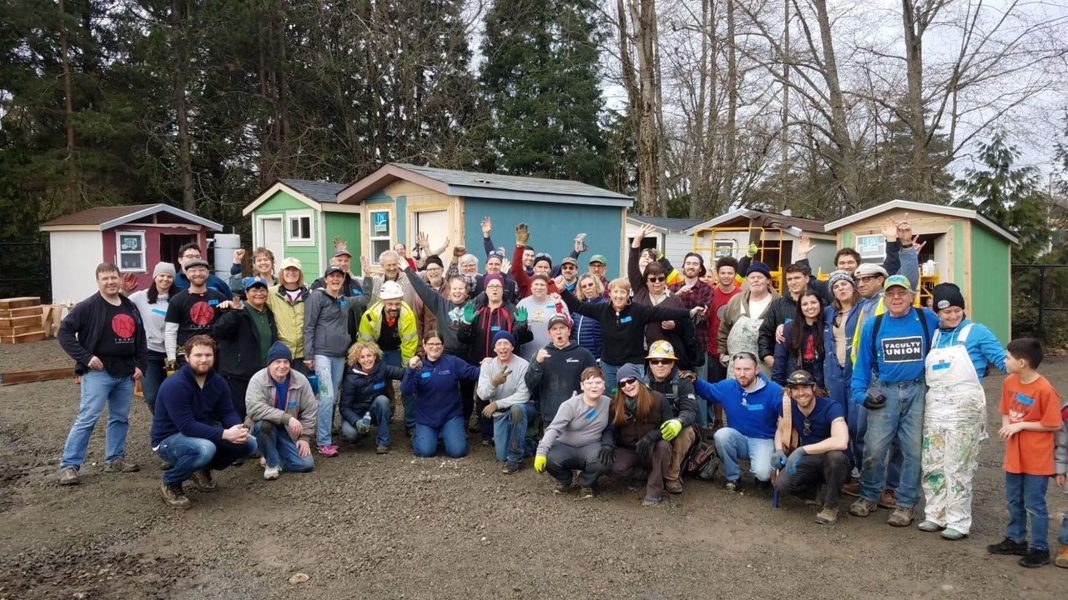The Plum Street Tiny House Village is a community-wide effort to help the homeless. The City of Olympia partnered with the Seattle-based Low Income Housing Institute (LIHI) to help build and run the site. LOTT Clean Water Alliance donated money for a hygiene trailer.  Many service organizations, schools, and contractors assembled the houses. Then hundreds of individual volunteers came to the Plum Street location on Saturdays for two months over the winter, dedicating their time and skills to put everything into place.
Many service organizations, schools, and contractors assembled the houses. Then hundreds of individual volunteers came to the Plum Street location on Saturdays for two months over the winter, dedicating their time and skills to put everything into place.
The tiny house village opened in February 2019, offering 29 shelters to homeless individuals previously living in tents downtown. “Once the village opened, there was an immediate impact on the downtown homeless population,” says Colin DeForrest, Homeless Response Coordinator for the City of Olympia.
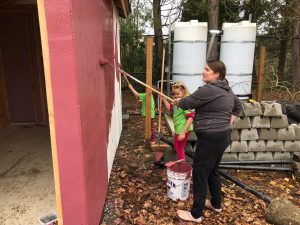
“This is shelter taking a new form. It tends to meet people’s needs far better,” says Brad Gerber, LIHI Tiny House Special Projects Manager. “The idea is for the tiny house village to be a bridge into permanent housing and self-sufficiency.” There is no limit to the length of time a person can stay at the village, however typically people stay four to six months. There are certain tasks residents are asked to perform and they need to check in regularly with their on-site case manager.
All the residents work with case managers. Together they come up with a plan for each person to become self-sufficient. The caseworker helps determine what barriers the person may have to finding a job and housing, like getting a driver’s license, a GED, drug or alcohol treatment, paying off fines, or putting together a resume. Sometimes they are referred to a wider range of services.
The Plum Street Village project began when the Olympia City Council declared homelessness a state of public health emergency in July 2018. Over that summer, the number of tents in the downtown core grew from 30 to over 300. The emergency declaration enabled the city to respond to the growing homeless population downtown more quickly. The council then tasked Colin DeForrest with thinking outside the box to come up with new ways to help the homeless.
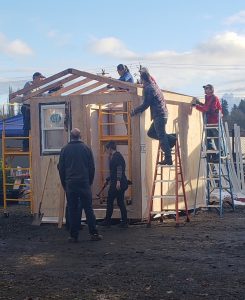
Colin knew of the tiny house projects in the Seattle area and began looking for a suitable location for a similar project in Olympia. The old city nursery property off of Plum Street came to mind. That site had many things going for it. It was city-owned and not in use as a nursery anymore. It was set back from the roads and surrounded by trees, which would afford residents some privacy and a nice setting. The necessary infrastructure like water, sewer, and fencing were already in place. Plus, two storage sheds could be repurposed.
Next Colin contacted LIHI. “LIHI is the gold standard for tiny houses,” says Colin. He reached out to LIHI Executive Director, Sharon Lee, and invited Sharon and her staff to Olympia to look over the site. “That meeting got the ball rolling,” says Colin, and the city quickly formed a partnership with LIHI to help develop and run Plum Street Village.
With LIHI’s experience at building and running tiny house homeless shelters, and the enthusiastic response from the Olympia community, the project was completed in about six months. Any work requiring a permit such as plumbing and electrical was performed by licensed professionals.
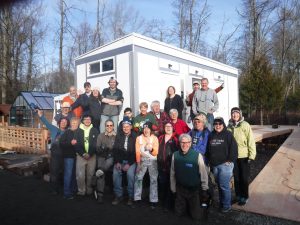
The tiny houses were built by volunteers both locally and across the state, including skilled contractors, faith communities, service organizations, and construction training programs at schools and prisons. Once assembled, the tiny houses were trucked to the Plum Street site.
Each house is 8’ x 12’, has a window, locking door, light, and heat. A plaque on each house tells who built it. The Lions Club, Saint Mark Lutheran Church, Cedar Creek Corrections Center, and the Gig Harbor Correction Center for Women are a few of the organizations that built a tiny house.
On Saturdays in late winter, volunteers gathered at the Plum Street property to prepare the site, and to build decks, porches, ramps, handrails, and pathways. LIHI networked with the faith communities to round up volunteers and many learned of the opportunity to lend a hand at public forums. “People showed up rain or shine,” says Brad. “Those days there would be four to five staff directing 60-70 volunteer laborers. It was a two-month intensive project.”
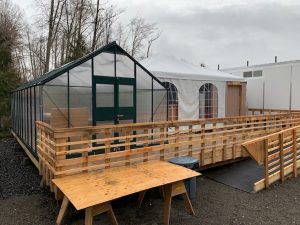
“People in Olympia were very eager to help. People showed up with skill and passion. It felt very different,” Brad says. “There’s something so unique about working in Olympia. Incredible folks.”
“Olympia really built this village,” adds Brad. “It’s important to know that human resources are there. People will come out of the woodwork and will make it happen.”
Plum Street Village offers privacy, a door and roof, clean water, electricity, a place to wash clothing, safety, and stability. According to Brad, with his experience in Seattle and Olympia, the tiny village model has proven to be an economically sound and effective way to help people out of homelessness.








































